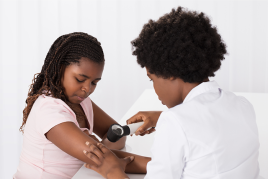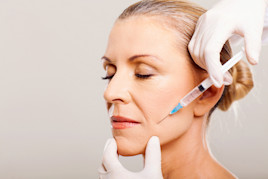How to decode sunscreen labels
What to look for in a sunscreen
Did you know that today’s sunscreens can help prevent sunburns, skin cancer, and premature skin aging, like wrinkles and age spots? Yet with so many sunscreens available, it can be overwhelming trying to figure out which sunscreen offers the best protection for you and your family. To help, dermatologists offer these tips.
Do you find the alphabet soup of terms on sunscreen confusing? If you answered yes, you’re in good company. A study published in JAMA Dermatology says that fewer than half of the patients at a dermatology clinic knew the meaning of terms like “broad spectrum” and “SPF.”
Some of these terms, such as “broad spectrum” and “SPF,” have very specific meanings because they come from standards created by the U.S. Food and Drug Administration (FDA) for testing sunscreen. Others lack this official meaning, but you’ll frequently see them on sunscreen.
Being able to decipher these terms can help you choose a sunscreen that gives you the protection you expect.
You’ll find everything you need to decode a sunscreen label below.
What is broad spectrum sunscreen?
FDA meaning: The sunscreen can protect you from the sun’s harmful ultraviolet A (UVA) and ultraviolet B (UVB) rays.
Why you want broad spectrum sunscreen
It can protect your skin from the sun's UVA (aging) rays and UVB (burning) rays, which helps prevent:
Skin cancer
Early skin aging (premature age spots, wrinkles, and sagging skin)
Sunburn
What is SPF?
FDA meaning: How well a sunscreen protects you from sunburn.
To simplify things, you may want to think of the sun protection factor (SPF) as the "sunburn protection factor."
About SPF numbers
Another confusing thing about SPF is the number that follows it. This number tells you how much UVB light (the burning rays) a sunscreen can filter out.
Here's what the science tells us about how much UVB light different SPF's can filter out:
SPF 15: 93% of the sun's UVB rays
SPF 30: 97% of the sun's UVB rays
The AAD recommends using an SPF 30 or higher.
It’s important to know that no sunscreen can filter out 100% of the sun’s UVB rays. That’s why it’s important to also seek shade and wear sun-protective clothing — such as a lightweight and long-sleeved shirt, pants, a wide-brimmed hat, and sunglasses with UV protection. For more effective protection, look for clothing with an ultraviolet protection factor (UPF) label.
What is waterproof sunscreen?
There's actually no such thing as waterproof sunscreen. Sweat and water wash sunscreen from our skin, so the FDA no longer allows manufacturers to claim that a sunscreen is waterproof. Some sunscreens are water resistant.
What is water resistant sunscreen?
FDA meaning: How long (either 40 or 80 minutes) the sunscreen will stay on wet skin. The sunscreen must undergo testing before it earns the water resistant designation.
Water resistant: The sunscreen stays effective for 40 minutes in the water. At that time, you'll need to reapply.
Very water resistant: The sunscreen stays effective for 80 minutes in the water. Yes, after 80 minutes, you'll need to reapply.
Even if your skin remains dry while using a water resistant sunscreen, you'll need to reapply the sunscreen every 2 hours.
Why reapply sunscreen?
Once applied, sunscreen only lasts so long on our skin. The sun's rays break down some sunscreens. Others clump and lose their effectiveness.
To continue protecting our skin from the sun when outdoors, we must reapply sunscreen:
Every 2 hours
After toweling off
When sweating*
After being in water*
*When using water resistant sunscreen, you'll need to reapply every 40 to 80 minutes.
What’s the difference between a chemical and physical sunscreen?
The biggest difference between these sunscreens is the active ingredients they contain. Here’s the lowdown:
Physical sunscreen: If the active ingredient in your sunscreen is titanium dioxide, zinc oxide, or both, you have a physical sunscreen. Dermatologists recommend physical sunscreen, also called mineral sunscreen, for people with sensitive skin.
Chemical sunscreen: If your sunscreen doesn’t contain titanium dioxide or zinc oxide, you have a chemical sunscreen.
Hybrid sunscreen: These sunscreens contain one or more active ingredients found in chemical and physical sunscreens.
To see what type of sunscreen you have, look on the sunscreen container at the section labeled “Active Ingredients.”
Whether you have a chemical, physical, or hybrid sunscreen, they all form a protective layer on your skin that absorbs the sun’s rays. In addition to absorbing the sun’s rays, physical sunscreens reflect the sun’s rays.
Any of these sunscreens can effectively protect you from the sun if you select one that offers all the following:
SPF 30 or higher
Broad-spectrum protection
Water resistance
What does the word “sports” mean on sunscreen?
The FDA has NOT defined this term for sunscreen.
When you see the word “sports” on sunscreen, it usually means that the sunscreen will stay on wet skin for either 40 or 80 minutes. To be sure, check the label. You may also see the words “water resistant” or “very water resistant.”
To protect your skin, you’ll need to reapply sports sunscreen:
When sweating (every 40 or 80 minutes)
After toweling off
After getting out of the water (or every 40 or 80 minutes)
Every 2 hours (when not sweating or in the water)
What does the word “baby” mean on sunscreen?
Like the word “sports,” the FDA has not defined this term for sunscreen.
In general, when you see the term "baby" on sunscreen, it means the sunscreen contains only these active ingredients:
Titanium dioxide
Zinc oxide
These ingredients are less likely to irritate a baby's sensitive skin.
The AAD recommends the following when using sunscreen on babies and toddlers:
Children younger than 6 months of age: Protect their skin from the sun by keeping them in the shade and dressing them in long-sleeved shirts, pants, wide-brimmed hats, and sunglasses. Take care, of course, to prevent overheating.
If possible, avoid using sunscreen on these children.
Children 6 months of age and older: Use a sunscreen that contains zinc oxide or titanium dioxide, which is most appropriate for the sensitive skin of infants and toddlers.
Even when using sunscreen, keep children in the shade and dress them in clothing that will protect their skin from the sun, i.e., long-sleeved shirts, pants, and wide-brimmed hats.
What does the term “sensitive skin” mean on sunscreen?
Again, the FDA does not define this term for sunscreen.
In general, if a sunscreen label says "sensitive skin," it often means that the sunscreen:
Contains one or both of these active ingredients — titanium dioxide and zinc oxide
Does NOT contain fragrance, oils, PABA, or active ingredients found in chemical sunscreens, which can irritate sensitive skin
Is hypoallergenic
Is it best to use sunscreen that contains insect repellent?
If a sunscreen label says it contains insect repellent, the AAD recommends looking for another sunscreen.
While both products provide important protection, the AAD recommends buying separate products because:
Sunscreen should be applied liberally and often
Insect repellent should be applied sparingly and less often than sunscreen
Now that you understand sunscreen lingo, here's a tip sheet that you can use while shopping for sunscreen: How to select a sunscreen.
References
Cole C, Shyr T, et al. “Metal oxide sunscreens protect skin by absorption, not by reflection or scattering.” Photodermatol Photoimmunol Photomed. 2016 Jan;32(1):5-10.
JAMA Dermatology news release, “How much do consumers know about new sunscreen labels?” Release issued June 17, 2015.
Zundell MP, Wong M, et al. “Letter to the editor: Improving patient communication on sunscreen choice: Updating mechanistic misconceptions.” J Eur Acad Dermatol Venereol Cli. Pract. 2023;1-2.
Last updated: 4/25/24
 Molluscum contagiosum: How to safely treat it
Molluscum contagiosum: How to safely treat it
 Biosimilars: 14 FAQs
Biosimilars: 14 FAQs
 Practice Safe Sun
Practice Safe Sun
 Relieve uncontrollably itchy skin
Relieve uncontrollably itchy skin
 Fade dark spots
Fade dark spots
 Untreatable razor bumps or acne?
Untreatable razor bumps or acne?
 Laser hair removal
Laser hair removal
 Scar treatment
Scar treatment
 Botox
Botox
 Free materials to help raise skin cancer awareness
Free materials to help raise skin cancer awareness
 Dermatologist-approved lesson plans, activities you can use
Dermatologist-approved lesson plans, activities you can use
 Find a Dermatologist
Find a Dermatologist
 What is a dermatologist?
What is a dermatologist?